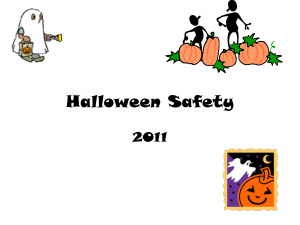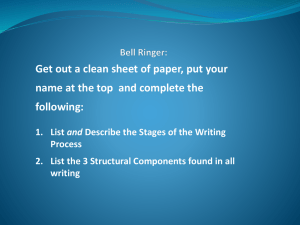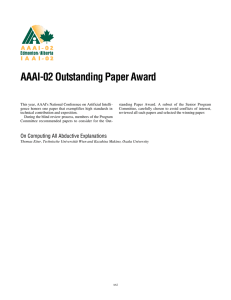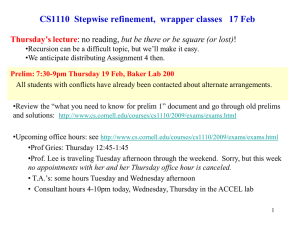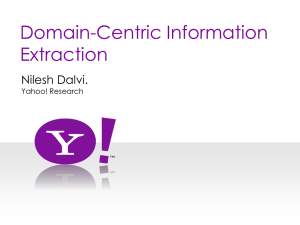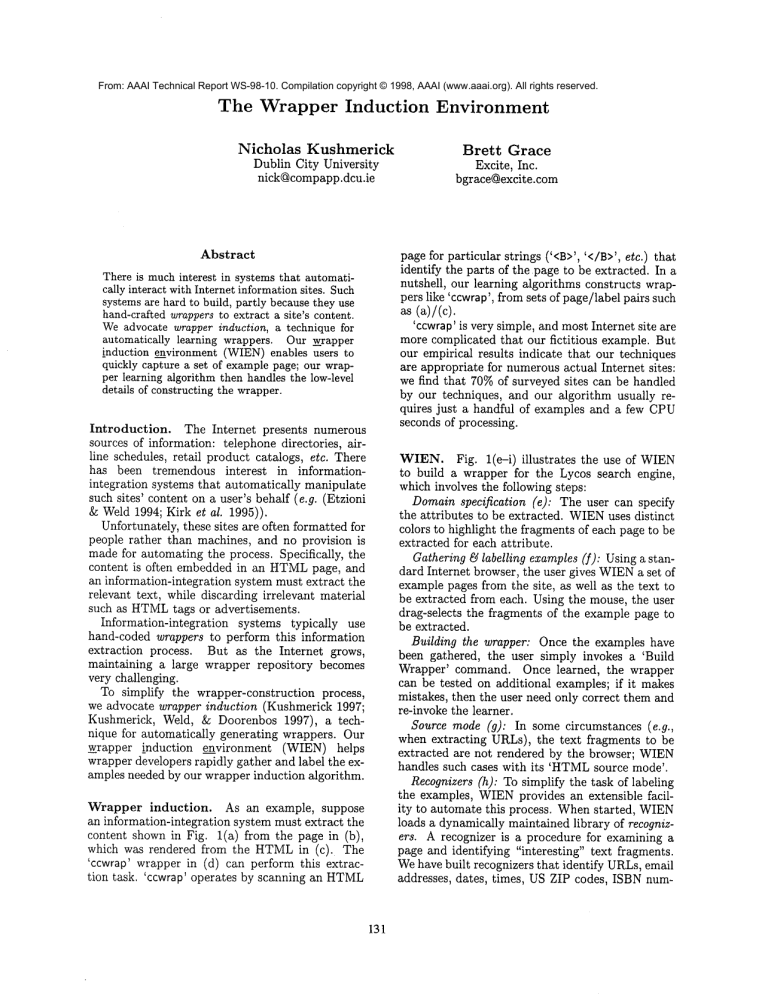
From: AAAI Technical Report WS-98-10. Compilation copyright © 1998, AAAI (www.aaai.org). All rights reserved.
The Wrapper Induction
Nicholas
Kushmerick
Dublin City University
nick@compapp.dcu.ie
Abstract
Environment
Brett
Grace
Excite, Inc.
bgrace@excite.com
page for particular strings (’<B>’, ’</B>’, etc.) that
identify the parts of the page to be extracted. In a
nutshell, our learning algorithms constructs wrappers like ’ccwrap’, from sets of page/label pairs such
There is muchinterest in systems that automatically interact with Internet informationsites. Such
systems are hard to build, partly because they use
hand-crafted wrappersto extract a site’s content.
Weadvocate wrapper induction, a technique for
automatically learning wrappers. Our wrapper
induction e_~nvironment(WIEN)enables users
quickly capture a set of examplepage; our wrapper learning algorithm then handles the low-level
details of constructing the wrapper.
as(a)/(c).
’ccwrap’ is very simple, and most Internet site are
more complicated that our fictitious example. But
our empirical results indicate that our techniques
are appropriate for numerousactual Internet sites:
we find that 70%of surveyed sites can be handled
by our techniques, and our algorithm usually requires just a handful of examples and a few CPU
seconds of processing.
Introduction. The Internet presents numerous
sources of information: telephone directories, airline schedules, retail product catalogs, etc. There
has been tremendous interest
in informationintegration systems that automatically manipulate
such sites’ content on a user’s behalf (e.g. (Etzioni
& Weld 1994; Kirk et al. 1995)).
Unfortunately, these sites are often formatted for
people rather than machines, and no provision is
made for automating the process. Specifically, the
content is often embedded in an HTMLpage, and
an information-integration system must extract the
relevant text, while discarding irrelevant material
such as HTMLtags or advertisements.
Information-integration
systems typically use
hand-coded wrappers to perform this information
extraction process. But as the Internet grows,
maintaining a large wrapper repository becomes
very challenging.
To simplify the wrapper-construction process,
we advocate wrapper induction (Kushmerick 1997;
Kushmerick, Weld, & Doorenbos 1997), a technique for automatically generating wrappers. Our
wrapper induction e_n_nvironment (WIEN) helps
wrapper developers rapidly gather and label the examples needed by our wrapper induction algorithm.
Wrapper induction.
As an example, suppose
an information-integration system must extract the
content shown in Fig. l(a) from the page in (b),
which was rendered from the HTMLin (c). The
’ccwrap’ wrapper in (d) can perform this extraction task. ’ccwrap’ operates by scanning an HTML
131
WIEN. Fig. 1(e-i) illustrates
the use of WIEN
to build a wrapper for the Lycos search engine,
which involves the following steps:
Domainspecification (e): The user can specify
the attributes to be extracted. WIENuses distinct
colors to highlight the fragments of each page to be
extracted for each attribute.
Gathering 8J labelling examples(/): Using a standard Internet browser, the user gives WIENa set of
example pages from the site, as well as the text to
be extracted from each. Using the mouse, the user
drag-selects the fragments of the example page to
be extracted.
Building the wrapper: Once the examples have
been gathered, the user simply invokes a ’Build
Wrapper’ command. Once learned, the wrapper
can be tested on additional examples; if it makes
mistakes, then the user need only correct them and
re-invoke the learner.
Source mode (g): In some circumstances (e.g.,
when extracting URLs), the text fragments to be
extracted are not rendered by the browser; WIEN
handles such cases with its ’HTMLsource mode’.
Recognizers (h): To simplify the task of labeling
the examples, WIENprovides an extensible facility to automate this process. Whenstarted, WIEN
loads a dynamically maintained library of recognizers. A recognizer is a procedure for examining a
page and identifying "interesting" text fragments.
Wehave built recognizers that identify URLs,email
addresses, dates, times, US ZIP codes, ISBNhum-
<’Congo’,
+242’),
(a)
I
(’Egypt’,
’20’),
<’Belize’,
+501’),
(’Spain’,
+34’)
(b)
Congo 242
Egypt20
Belize 501
Spain 34
ccwraPLR(page
P)
<HTML><TITLE>Some
CountryCodes</TITLE><BGBY> procedure
whilethereaxemoreoccurrences
in P of ’<B>’
<B>Congo</B><I>242</I><BR>
for
each
((k,rk)
E
{(’<B>’,
’</B>’I,<’<I>’,
’</I>’)}
<B>Egypt</B>
<I>20</I><BR>
(c) <B>Beiize</B>
<I>501</I><BR>
(d)
scan in P to next occurrence of ek
scan
in
P
to
next
occurrence
of
rk
<B>Spain</B><I>34</I><BR>
return extracted <..., (country, code),...} pairs
</BGDY></HTML>
(e)
(f)
(g)
(h)
.+:
~:~::~’;~
:~ ~’:~?~?:
r ~’;; "~:’:7
Figure
~
~’f:2~;~
1: An example (a-d),
and the WIEN application
(e-h).
References
bers, and so forth; more sophisticated
recognizers
might try to locate company or personal names.
Ashish, N., and Knoblock, C. 1997. Semi-automatic
wrapper generation for Internet information sources¯
In Proc. Cooperative Information Systems.
Etzioni, O., and Weld, D. 1994. A softbot-based interface to the Internet. C. ACM37(7):72-6.
Hsu, C. 1998. Initial Results on Wrapping Semistructured Web Pages with Finite-state
Transducers and
Contextual P~ules. In Workshop on AI and Information Integration, AAAI-98.
Discussion.
WIEN was developed in the specific
context of our work on wrapper induction,
but we
believe that our tool is applicable more generally,
and we hope that WIEN is useful to the wrapper induction community at large (e.g.,
(Ashish
& Knoblock 1997; Hsu 1998)).
To this end,
have designed WIEN so that its learning
module
is cleanly decoupled from the labeling and recognizer facilities.
WIENis available
at www.compapp.dcu.ie/~nick/research/wrappers/wien.
Kirk, T.; Levy, A.; Sagiv, Y.; and Srivastavu, D. 1995.
The Information
Manifold. In AAAI Spring Symposium: Information Gathering from Heterogeneous,
Distributed Environments, 85-91.
Kushmerick, N.; Weld, D.; and Doorenbos, R. 1997.
Wrapper Induction for Information Extraction.
In
Proc. 15th Int. Joint Conf. AA
Kushmerick, N. 1997. Wrapper Induction for Information Extraction. Ph.D. Dissertation, Univ. of Washington.
Acknowledgements.
This research
was conducted
in collaboration with Dan Weld at the Univ. of Washington, and was funded by ONRGrunt N00014-941-0060, NSF Grant IRI-9303461,
ARPA/Rome Labs
grant F30602-95-1-0024, and Rockwell International
Palo Alto Research.
132

